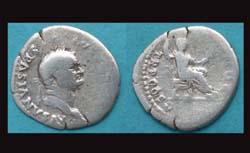Ave!
Aes Rudes, Roman Republic and Central Italy, c. 5th - 4th Century B.C.
Æ; Sizes and weight will vary
Now available at only $30 per ounce!
This is important so please read before making your purchase!
For instance, the big ingot in the 2nd photo is 44mm and weighs one ounce. On the other hand, the 3rd photo reflects four smaller ingots at one ounce as well. To make this as simple as possible, upon purchase, you can request larger or smaller pieces while our supplies last.
Con/ All as Smelted; Furnace fresh, with wonderful and eye-pleasing sinuosity, loops and bends
Ref/ BMCRR I p. 1, Haeberlin pl. 1, Vecchi ICC pl. 1, Thurlow-Vecchi pl. 2, SRCV I 505
Why are these rare? Common sense tells us that eventually all were melted down and cast into any number of products such as lamps, tools, weapons, rings, and other implements, etc.
Providence/ From a hoard of aes rudes that was in the collection of an 19th century English gentleman who traveled extensively throughout northern and central Italy during the 1870s and 1880s.
Seller's Note/ In Italy, as with other nations, early trade used a system of barter. Aes rude (Latin: "rough bronze"), were used perhaps as early as the early 8th century B.C. and was the earliest metal proto-money currency in central Italy. In the 5th century B.C., bronze replaced cattle as the primary measure of value in trade.
Aes rudes are rough lumpy bronze ingots with no marks or design, some are flat and oblong, others are square, while many are irregular and shapeless. The metal is mostly copper with roughly 5% tin. Weight varied considerably with some exceeding twelve pounds and others under an ounce. Many smaller examples are fragments of broken larger specimens. A balance was necessary to measure value for commercial transactions.
From the early bronze age metal was used to manufacture implements and weapons and copper or bronze in any form was a valuable trade good. Metal is particularly useful for barter because it is compact, portable, easy to store, and does not spoil. The first type of smelted bronze bullion metal cast by Romans was rough lumps of bronze known as "aes rude" (rough bronze) pieces of no precise weight and a variety of sizes. Axe heads, rings, cast bronze shells, rods, bars, and ingots, for example, traded alongside aes rude. All bronze objects were suitable for trade by their weight and were frequently broken to adjust their weight and to make change.
Despite its great advantages, it was not until the middle of the 5th century B.C. that bronze replaced cattle as the primary measure of value in Roman trade. The Roman Lex Aternia et Tarpeia (c. 454 B.C.) a.k.a. "Tarpeian Law" replaced livestock as 'money' with copper, defined as weight of metal per ox (cattle). The Republican law stated oxen were to be valued at 100 libra (pounds) of copper each and sheep at 10 libra.





